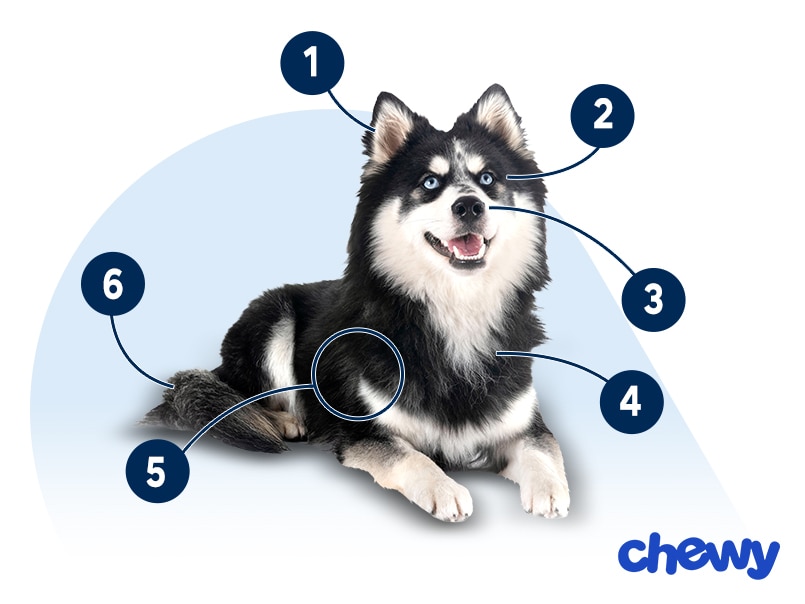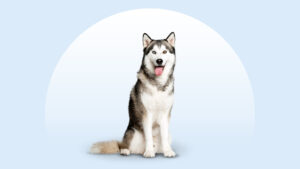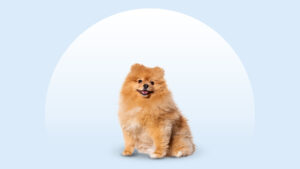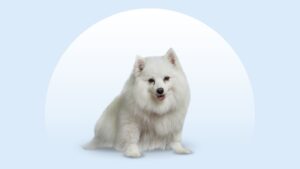Pomsky
Updated July 8, 2025
Pomsky
Updated July 8, 2025
The Pomsky is a Pomeranian-Husky mix with warm, friendly eyes and a temperament to match. This relatively new designer breed has become a popular choice thanks to their keen intelligence, manageable size, and quirky personality.
Spirited, Gregarious, Headstrong
16–24 pounds
10–18 inches
12–14 years
Black and White, Silver and White, Red and White, Chocolate, Agouti, Sable, Black and Tan, Wolf Gray, White, Black, Dilute Black, Lavender, Merle, Piebald, Brindle, Tan Point
What is a Pomsky if not your very own tiny, wolf-like companion who’s always ready to join you for adventure and cuddles?
A cross between the majestic Siberian Husky and the tiny Pomeranian, these dogs have big personalities that will keep you laughing. Get used to meeting all your neighbors, because everyone will want a chance to pet your adorable, social Pomsky.
Pomsky Characteristics
Pomsky Appearance
With a crossbreed like the Pomsky, there’s never a single right answer to questions like “How big does a Pomsky grow?” or “What color is a Pomsky’s coat?”
This breed combines the wolflike characteristics of the Siberian Husky with the small stature and fluffy coat of the Pomeranian. So, you’ll find lots of variance between Pomskies, but most are under 18 inches tall and have a fluffy, thick coat.
Groups like the American Pomsky Kennel Club (APKC) are working to create a formal Pomsky breed standard, but Pomsky dogs (like all mixed breeds) aren’t recognized by the American Kennel Club (AKC).

- Ears
Pomsky ears are small, triangular, and erect. They sit high on the head with an outward tilt and are covered in fur.
- Eyes
Their bright, expressive eyes are almond or round and come in a number of colors, including brown, blue, amber, green, hazel, gray, heterochromia (two different-colored eyes), mosaic, and parti (multiple colors in the same eye).
- Nose
The Pomsky’s nose is slightly round and may be black, brown, liver, or pink. Some Pomsky dogs will inherit a snow nose from their Husky parent, which causes the nose to lighten during colder months.
- Coat Length
A Pomsky’s coat may be standard (short length), plush (medium length), wooly (long length), or extreme wooly (triple coat). They have a dense undercoat that helps with insulation.
- Coat Color
Their coat comes in many colors and combinations, including agouti, black and white, black, blue, lavender, red, sable, silver and white, white, merle, brindle, and piebald (white fur with patches of color). Many Pomskies have distinct face masks.
- Tail
Their fluffy, plumed tail curls over their back in an arch.
Pomsky Temperament
While every dog is an individual, many Pomskies are loving, loyal, full of energy, and have a quirky personality. They love to spend time with their family, whether you’re sitting around or running around. And with proper socialization early on, Pomsky dogs can quickly make friends with other animals, new people, and kids.
“They are bred to be companions, and thrive in the company of humans and other dogs,” says Rachel Morin, secretary and director of marketing for the APKC and owner of Golden State Pomskies.
Pomskies inherit their high energy and sense of adventure from their Siberian Husky side. Some will crave lots of activity, but most are adaptable to your lifestyle as long as they get twice-daily walks. They’ll be just as happy swimming or camping as they are cozying up with you.
“They love to be loved,” says Kimberly Baumann, vice president and director of education for the APKC and owner of KP Pomskies. “They tend to be cuddlers.”
Bright-eyed and with lots of brains, Pomskies need lots of daily mental stimulation. Training your Pomsky puppy early on is essential; it can help reduce unwanted behaviors like excessive barking or chewing.
As long as you are consistent about training and engaging your dog, full-grown Pomskies and puppies alike can be polite, affectionate companions.
How to Care for a Pomsky
Like their Pomeranian and Husky ancestors, Pomskies are highly intelligent dogs with a lot of fur. This means that grooming, training, exercise, and mental stimulation are all important aspects of their care.
Grooming
Training
Diet
Exercise
Environment
Pomsky Health
The average Pomsky life expectancy is 12–14 years. These pups are typically healthy, especially those who come from breeders who test for health issues.
But common conditions can still pop up, including:
- Luxating patella: This condition occurs when the kneecap (patella) slides out of place. Patellar luxation is a common orthopedic issue for small dogs like the Pomeranian, so Pomskies are susceptible, too.
- Dental disease: Small breeds, including the Pomsky, are prone to dental problems like periodontal disease. Regular brushing and dental cleanings can help prevent complications down the line.
- Joint problems: Pomskies are prone to elbow and hip dysplasia. Both are caused when the joints don’t develop properly, causing pain, problems with mobility, and arthritis in dogs. Both hip and elbow dysplasia may be treated medically, through lifestyle changes, or with surgery.
- Eye issues: Both Huskies and Pomeranians can be prone to eye problems that Pomsky puppies could inherit. Common issues include cataracts and progressive retinal atrophy (PRA), both of which ultimately hinder vision. Cataracts are treatable with surgery, but PRA can’t be reversed.
Pomsky History
The Pomsky has been around since about 2012, when a handful of breeders decided to try creating a smaller version of the Siberian Husky. By mixing the Husky with one of the smallest dog breeds, they bred a dog who resembled a tiny little wolf.
“Due to the size difference between the parent breeds, Pomskies are bred using artificial insemination, with the Husky as the mother,” Jones says.
The Pomeranian-Husky blend created a dog who was upbeat, smart, and social—not to mention terribly cute. By 2014, the Pomsky had caught on as a popular designer dog.
“Everybody really started recognizing that this could be a really cool breed,” Baumann says.
Although the Pomsky is not (yet) recognized by the AKC, groups such as the APKC and the Pomsky Owners Association are hard at work creating breed standards so the Pomsky can someday be a recognized breed.
If you’re interested in adding a Pomsky to your family, Baumann recommends using the APKC website to find a responsible breeder invested in giving dogs healthy, quality lives.





